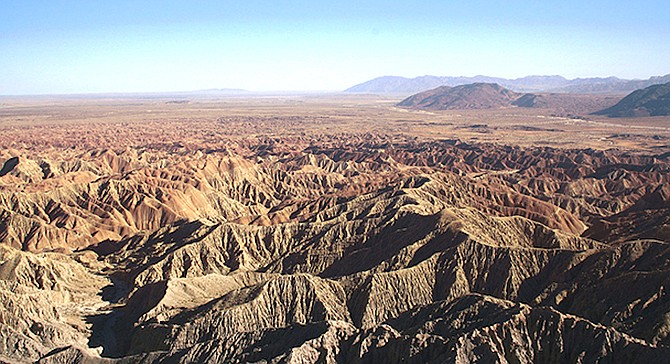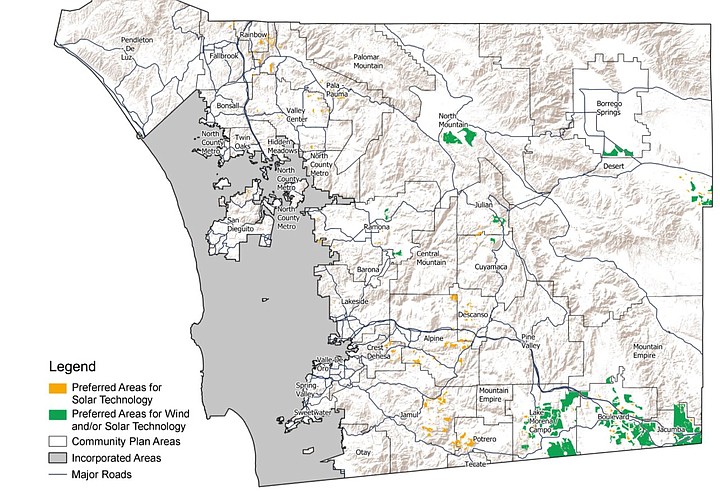 Facebook
Facebook
 X
X
 Instagram
Instagram
 TikTok
TikTok
 Youtube
Youtube

Where's the best place for renewable energy? Many backcountry locals think San Diego rooftops would be ideal. The county, however, is eyeing the wide open spaces of the desert.

Out where bighorn sheep roam, the Milky Way is always on at night, and the Anza Borrego Desert State park unfurls over 1,000 square miles. Officials say large scale wind and solar are needed to meet the county's goal to achieve 90 percent renewable electricity for the unincorporated area by 2030, a plan that will include community choice energy.
But a desire for a different kind of community choice has slowed things down. From Boulevard to Borrego Springs, those who support renewable energy are objecting to the county's plan to fast-track permits.
"I just don't want to be a victim of the overlay," said Kerry Forrest, chair of the Descanso planning group, at a November outreach meeting.
Last week, the board of supervisors voted unanimously to continue a discussion on options for streamlining permits for solar and wind to a February meeting. A proposed overlay zone was developed to help minimize land-use conflicts and pinpoint the most suitable sites in the backcountry.
The overlay sets up boundaries for specific areas and establishes different land-use and environmental review requirements within them. County planners came up with three options for streamlining and overlay zones: large scale solar projects, large scale wind energy, and combined solar and wind. Each requires an environmental impact report.
For solar, the areas found to have the most potential are within the Mountain Empire, North Mountain, Central Mountain, Jamul-Dulzura and Alpine; for wind it's Mountain Empire, North Mountain and Central Mountain areas. Big solar projects can produce enough energy to power roughly 618,000 homes for a year compared to 89,000 homes for wind, planners say.
But some see maximizing rooftop solar in urban environments as a better solution than remote transmission. Residents of Borrego Springs, which has two large solar projects that supply 100 percent of local energy from renewable sources, voiced frustration that the Anza Borrego Desert State Park, which surrounds them, wasn't included as a stakeholder.
The southern edge of the valley borders the park. A magnificent viewshed is at stake, not only for the community but all park visitors, said Bri Fordem, executive director of the Anza Borrego Foundation.
"We feel the locations selected in Borrego Springs are not suitable for an industrial scale energy project. If the board proceeds with the renewable energy overlay project, we ask that any and all lands from Borrego Springs be removed from consideration."
Another opponent pointed out that there's only one power line in and out of the community. The line, owned by San Diego Gas & Electric, runs through the state park and if more projects are approved would have to be enlarged in order to transport renewable energy out of the valley.
Expanding the line would require changes to the park's general plan. And land would have to be removed from the state-designated wilderness areas, requiring an act by the state legislature.
Environmental advocates questioned if any of the three options will be developed in concert with the climate action plan and multi-species conservation plan. "I'm very unclear how any overlay or other plan will work with the [conservation plan] considering that these overlays are in a very conceptual state right now," said botanist Frank Landis.
"Conflicts between the plans could be disastrous."
The board will take up the overlays again on Feb. 10, and agreed to add Anza Borrego Desert State Park as a stakeholder.


Where's the best place for renewable energy? Many backcountry locals think San Diego rooftops would be ideal. The county, however, is eyeing the wide open spaces of the desert.

Out where bighorn sheep roam, the Milky Way is always on at night, and the Anza Borrego Desert State park unfurls over 1,000 square miles. Officials say large scale wind and solar are needed to meet the county's goal to achieve 90 percent renewable electricity for the unincorporated area by 2030, a plan that will include community choice energy.
But a desire for a different kind of community choice has slowed things down. From Boulevard to Borrego Springs, those who support renewable energy are objecting to the county's plan to fast-track permits.
"I just don't want to be a victim of the overlay," said Kerry Forrest, chair of the Descanso planning group, at a November outreach meeting.
Last week, the board of supervisors voted unanimously to continue a discussion on options for streamlining permits for solar and wind to a February meeting. A proposed overlay zone was developed to help minimize land-use conflicts and pinpoint the most suitable sites in the backcountry.
The overlay sets up boundaries for specific areas and establishes different land-use and environmental review requirements within them. County planners came up with three options for streamlining and overlay zones: large scale solar projects, large scale wind energy, and combined solar and wind. Each requires an environmental impact report.
For solar, the areas found to have the most potential are within the Mountain Empire, North Mountain, Central Mountain, Jamul-Dulzura and Alpine; for wind it's Mountain Empire, North Mountain and Central Mountain areas. Big solar projects can produce enough energy to power roughly 618,000 homes for a year compared to 89,000 homes for wind, planners say.
But some see maximizing rooftop solar in urban environments as a better solution than remote transmission. Residents of Borrego Springs, which has two large solar projects that supply 100 percent of local energy from renewable sources, voiced frustration that the Anza Borrego Desert State Park, which surrounds them, wasn't included as a stakeholder.
The southern edge of the valley borders the park. A magnificent viewshed is at stake, not only for the community but all park visitors, said Bri Fordem, executive director of the Anza Borrego Foundation.
"We feel the locations selected in Borrego Springs are not suitable for an industrial scale energy project. If the board proceeds with the renewable energy overlay project, we ask that any and all lands from Borrego Springs be removed from consideration."
Another opponent pointed out that there's only one power line in and out of the community. The line, owned by San Diego Gas & Electric, runs through the state park and if more projects are approved would have to be enlarged in order to transport renewable energy out of the valley.
Expanding the line would require changes to the park's general plan. And land would have to be removed from the state-designated wilderness areas, requiring an act by the state legislature.
Environmental advocates questioned if any of the three options will be developed in concert with the climate action plan and multi-species conservation plan. "I'm very unclear how any overlay or other plan will work with the [conservation plan] considering that these overlays are in a very conceptual state right now," said botanist Frank Landis.
"Conflicts between the plans could be disastrous."
The board will take up the overlays again on Feb. 10, and agreed to add Anza Borrego Desert State Park as a stakeholder.
Comments